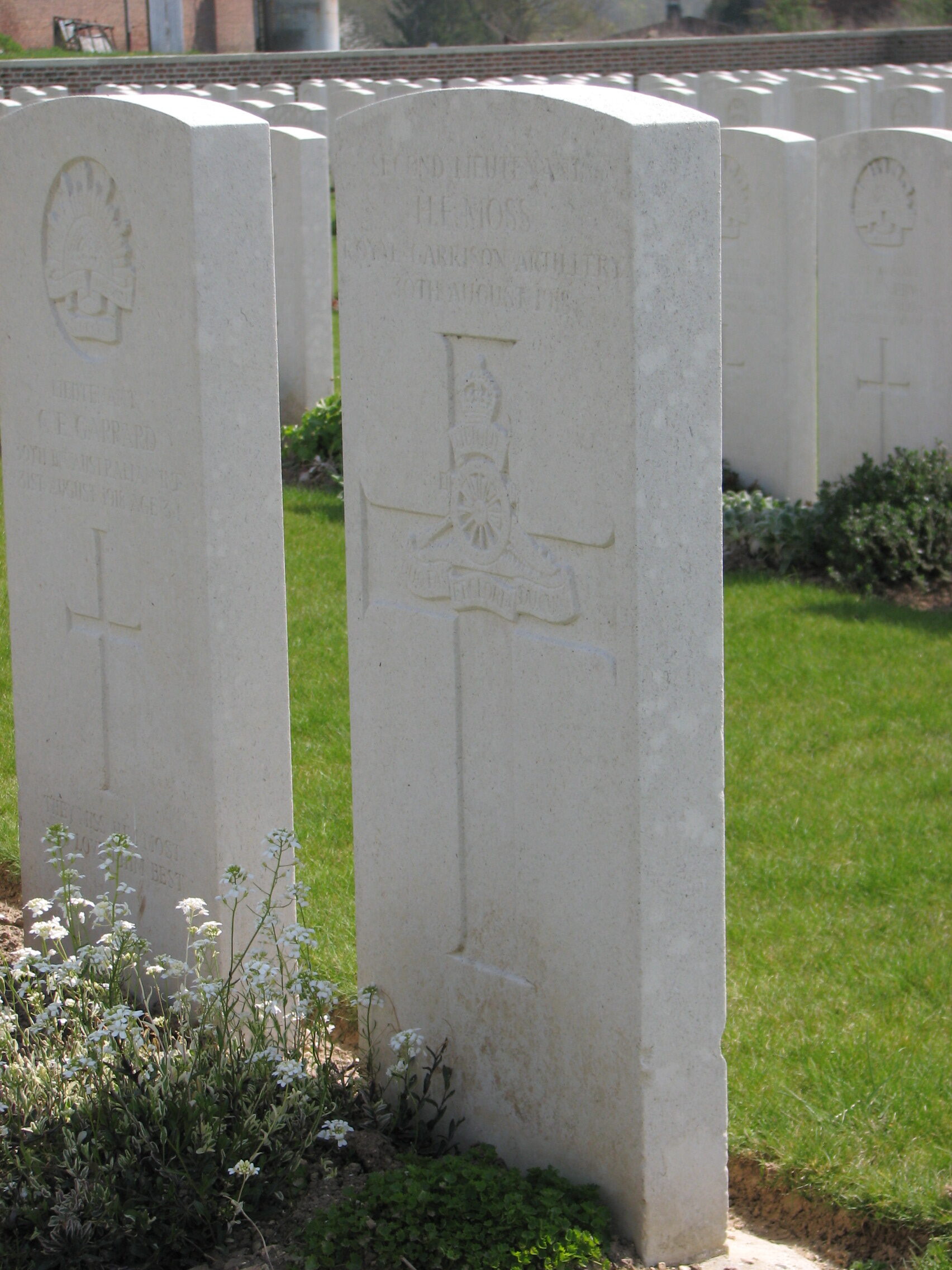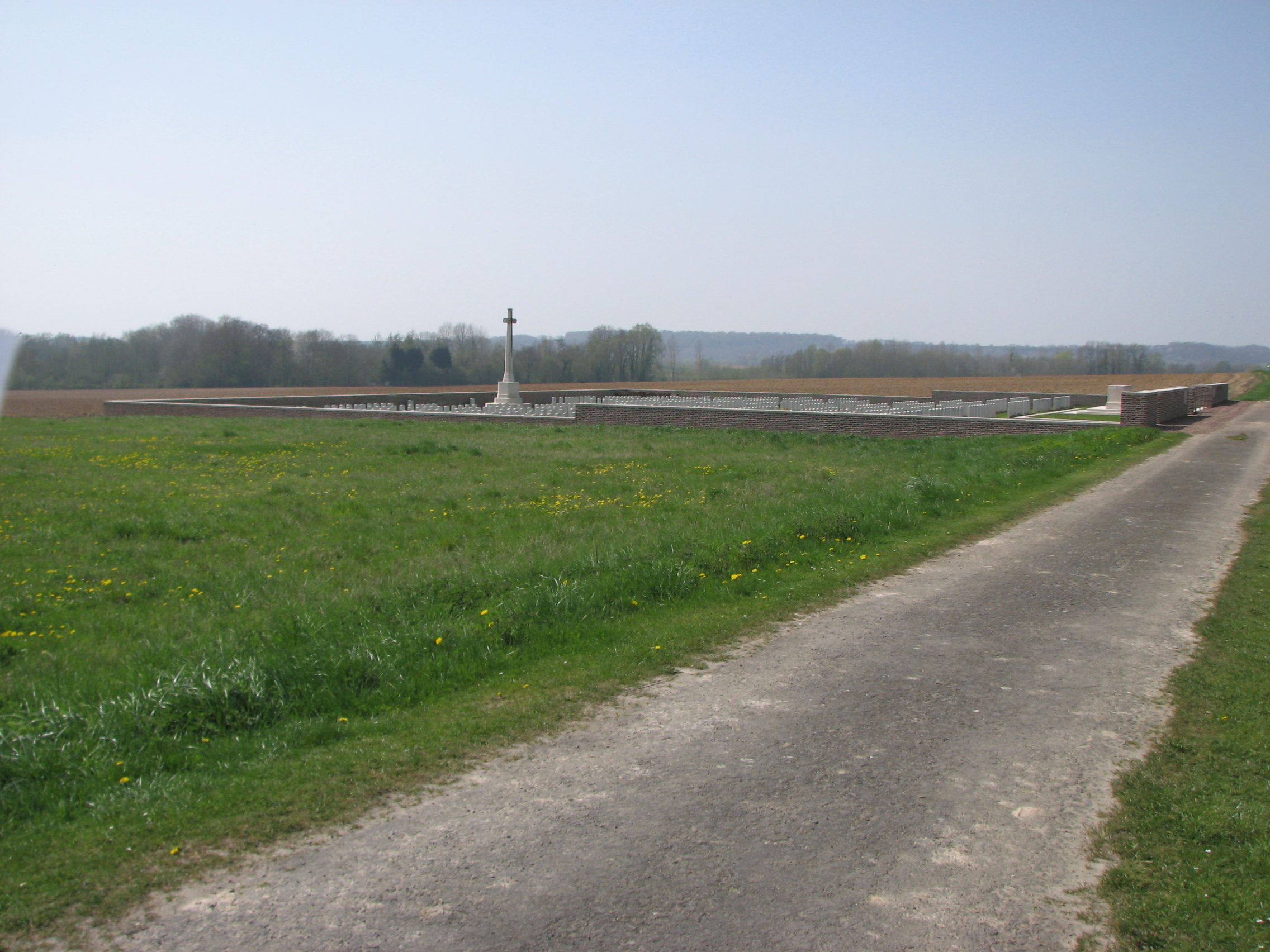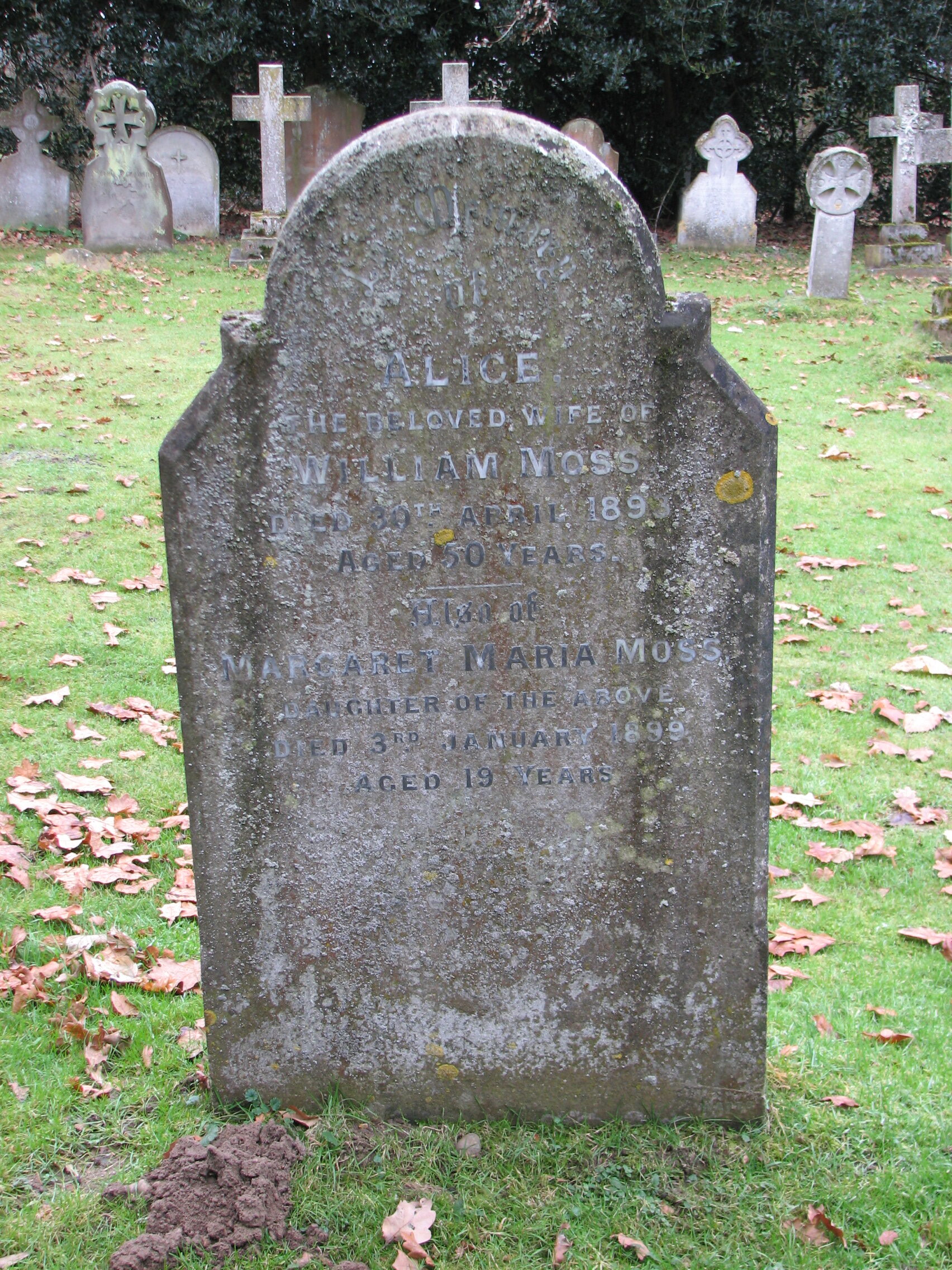Herbert Moss (1887 - 1918)
Brother of Arthur Moss. Herbert “rose up from the ranks” and became an officer. He served with the Royal Garrison Artillery on the Western Front and was killed in the closing months of the War.
- 46
- Died in the Great War
- 51.971236, 1.010844
Details
| Name: | Herbert Frank Moss |
| Service: | British Army |
| Unit: | 132nd Heavy Battery, Royal Garrison Artillery |
| Rank: | 2nd Lieutenant |
| Date of Death: | 30th August 1918 |
| Age: | 31 |
| Buried: | Plot II, Row C, Grave 10, Hem Farm Military Cemetery, Hem-Monacu, near Albert, France |
Family Background and Early Life
Herbert Moss was born in East Bergholt on 23rd July 1887.
At the time of Herbert’s birth, his father William’s occupation was given as Job Master, though in the Census returns he was described as a Cab Proprietor.
William – who had been born in East Bergholt – initially worked as a Coachman. He had married Alice Carr from Weasenham St. Peter near Swaffham in Norfolk, in 1868 at Stepney in London.
There is some evidence that William and Alice may have lived for a short time in East Mersea, but from 1871 they settled in Brantham, and it was there that most of Herbert’s 8 brothers and sisters were born.
The Moss family moved to East Bergholt just before Herbert was born. They made their home at the junction of The Street and Cemetery Lane in what was then called the Livery Stables, but is now called Moss Cottage (the cottage being the living quarters next to the actual Stables).
Alice Moss died at the age of 50, when Herbert was just 6 years old. The following year, William married Lucy Pinkney from Stutton, and together they had 3 children. footnote] Herbert’s half-brother Arthur, the youngest child from William’s second marriage, is also commemorated on the East Bergholt War Memorial. Arthur Moss of the Machine Gun Corps, was killed when the ship on which he was being transported, struck a mine and sank in Alexandria harbour, Egypt. He was 19 years old. Arthur is buried in the Alexandria (Hadra) War Memorial Cemetery.[/footnote] Less than 3 months after the youngest of these children had been born, Herbert’s older sister Margaret died, at the age of 19.
Herbert started at the village school at Burnt Oak Corner in September 1891, and remained as a pupil there until July 1900. Unusually for the time, he then continued his education for another 2 years, at the Ipswich Secondary School which was then located on Tower Ramparts.
Civil Service
Finally leaving school in July 1902, Herbert started work as a Civil Servant. This is almost certainly the time that he moved away from East Bergholt. The April 1911 Census shows Herbert living in Upper Edmonton, Middlesex with his sister Alice (whose married name was Garnham) and her family. Herbert was employed as an Accountant in the Civil Service, at one of the government departments in Whitehall.
The Group Scheme
Herbert joined the British Army under the Derby Scheme in December 1915, and under the terms of this arrangement opted to defer his call up. 1 Officially called the Group Scheme, it was often called the Derby Scheme after Lord Derby, the Director-General of Recruiting. The Scheme was effectively a last ditch attempt by the government to increase recruitment by voluntary means, before they had to resort to conscription. It permitted a man to enlist and then – if he chose to – be immediately transferred temporarily to the Army Reserve and g o back to his civilian occupation until he was formally required. He was officially called up – or mobilised – on 13th May 1916, and entered service with the Royal Garrison Artillery (R.G.A.) as a Private. 2 The Royal Garrison Artillery was one of three branches of the Artillery and was armed with heavy guns and howitzers. The size and range of the Royal Garrison Artillery’s weapons meant that they were positioned some way behind the front line. Their usual role was to destroy or neutralise the enemy artillery, as well as put destructive fire down on strongpoints, dumps, stores, roads and railways behind enemy lines.
At the time he enlisted, Herbert was described as being 5 foot 11 ¼ inches tall, weighing 133 lbs and having a birth mark on his right temple.
Much of Herbert’s training took place at Bexhill-on-Sea in East Sussex, during which he was described as being “Very Good” at Plotting & Observation of Fire. Herbert evidently showed promise during his training, as he was promoted twice – first to the rank of Bombardier, and then to Corporal.
On 15th July 1916, Herbert married 28 year old Olive Hills at St George’s Church in Waltham Cross. Their address on the Marriage Register entry is given as 34 Uckfield Road, which was in neighbouring Enfield Lock.
France and Belgium
One week before his marriage, Herbert had been posted to the 168th Siege Battery, R.G.A. 3 The Royal Garrison Artillery was made up of Siege Batteries and Heavy Batteries. The former being armed with heavy howitzers, sending large calibre high explosive shells in high trajectory, plunging fire, whilst the latter were armed with heavy guns, sending large calibre high explosive shells in fairly flat trajectory fire. On 22nd September 1916, the Battery – including Herbert – disembarked in France, joining the British Expeditionary Force (B.E.F.).
The Battery were sent to the north to the Ypres Salient, and for some time at least were positioned in the ruined town itself. There they provided support to the infantry, and also engaged in counter-battery work trying to knock out the German artillery.
The promise that Herbert had shown early on was obviously evident to his superiors, and he was selected as likely officer material. On 17th February 1917, he left France for England, and was sent initially to 2 Depot, and then to Officer Cadet School which was situated at Maresfield Park, Uckfield in East Sussex.
Commissioned as a 2nd Lieutenant
After spending 5 months undergoing officer training, on 20th July 1917 Herbert was commissioned as a 2nd Lieutenant in the Royal Garrison Artillery. He returned to France the following day, though he appears to have remained at the Base Depot for two months – probably undergoing further training – before being posted to a Battery.
Herbert was transferred to the 132nd Heavy Battery on 12th October. Still a part of the Royal Garrison Artillery, they were equipped with 60 pounder field guns rather than the howitzers of the Siege Batteries.
The Battery spent the period from 21st November to 16th December undergoing a rest and refit, and then transferred south to the area approximately 12 miles west of Peronne, in the department of the Somme.
The German Spring Offensive
Herbert spent the first two weeks of March on leave in the UK. On 21st March, the Germans launched Operation Michael – the first in a series of massive offensives directed primarily against the British. They were intended to knock the British out of the war, and cause the French to sue for peace before the presence of increasing numbers United States troops was felt on the Western Front.
Such was the speed of the German advance on 21st March that before they retreated, 4 of 132 Battery’s 6 guns had to be abandoned. They had either been destroyed by the German shelling, or had to be destroyed by the men of the Battery themselves because they could not be withdrawn in time.
Along with a large part of the Fifth Army, the Battery conducted a fighting withdrawal. The British losses in both men and territory caused a crisis, but with French assistance the front was eventually stabilised in early April.
After having been relieved in mid-April, the Battery spent the remainder of the month refitting in both men and guns. They were back in action at the start of May, this time a few miles east of the old 1916 Somme battlefields. Such was the extent of the German advance in March and early April, that in places the front had been pushed back over 30 miles.
In the summer, Herbert was transferred to the Battery’s parent unit, 76 Brigade. Royal Garrison Artillery. Over the next few months, he undertook a variety of duties: He was at the Brigade’s Ammunition Dump for most of June and July, and for a week in early August he was appointed as the temporary Area Commandant for the village of Behencourt Montigny.
On 8th August 1918 the British launched a limited – albeit extremely successful offensive. 76 Brigade R.G.A. took part, with “all guns remaining in action throughout the day, and completing their tasks as allocated.” 4 Taken from the War Diary of 76 Brigade, R.G.A. for August 1918 (National Archives WO 95/ 477).
“The Hundred Days”
History now sees the offensive of 8th August is as the start of what is called “The Hundred Days”, a series of victories for the Allies which culminated in the Germans suing for peace and signing the Armistice on 11th November.
In late August, a second offensive was launched and in just the matter of a few days the British retook the ground of the old 1916 Somme battlefield. It was during this offensive that Herbert was killed.
Officially, Herbert is recorded as having been killed in action on 30th August 1918. However, the evidence strongly indicates that in fact he was killed on the following day.
The Brigade’s War Diary for 31st August – written at the time states:
“The attack was again continued in the early morning. Marrieres Wood taken and the line advanced. The enemy delivered a counter-attack soon after noon from Rancourt and advanced to positions about 700 or 800 yards from 19 S.B. and 233 S.B. positions. The attack was completely repulsed. Casualties: 2/Lt. H.F. Moss killed; 1 O.R. killed, 2 O.Rs wounded.” 5 Taken from the War Diary of 76 Brigade, R.G.A. for August 1918 (National Archives WO 95/ 477).
On 3rd September, the War Office sent the following telegram to Olive:
“Deeply regret 2/Lt HF Moss RGA 132 Hvy Bty killed in action August thirty first. The Army Council express sympathy.”
Postscript
Herbert was initially buried the nearby French Military Cemetery at Curlu. Two years later, Herbert’s body was exhumed and reburied in the nearby Hem Farm Military Cemetery, overlooking the River Somme at Hem-Monacu. 6 This was as part of the move by the Imperial War Graves Commission (renamed the Commonwealth War Graves Commission in 1960) to concentrate isolated graves, as well as those in small French or German cemeteries, into larger, permanent cemeteries. He rests there still.
Herbert is also remembered on a commemorative stone in East Bergholt Cemetery, which was erected by his widow, Olive. It is in the shape of a cross and now stands at the back of the headstone marking the grave of Herbert’s mother’s and his sister, Margaret. The text is now becoming increasingly difficult to see, but part of it reads:
“EVER LOVING
MEMORY OF
MY DEAR HUSBAND
HERBERT FRANK MOSS
2nd LIEUT. ROYAL GARRISON ARTILLERY
KILLED IN ACTION IN FRANCE 31st AUGUST 1918
AGED 31 YEARS”
Olive never remarried. She died at the age of 82 in 1968.
Copyright © Mark Ashmore, 2024
- 46
- Died in the Great War
- 51.971236, 1.010844





